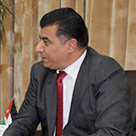
Khaled Hanifat
Minister of Agriculture
Agriculture & Fisheries / Jordan
“We managed to achieve 10% growth in 2017”
As one trade border opens, another closes. Thus is the continuous gauntlet that Jordan’s exporters must overcome. Yet, miraculously, the Kingdom’s agriculture industry has managed to adapt to the mercurial regional setting, posting 10% growth in 2017. Minister of Agriculture Khaled Hanifat guides us through the highs and lows.
What are the main challenges impeding agricultural growth today?
Our current problems are related to the closure of borders with several trade partners. We have active producers, but had we had easier access to foreign markets, our situation would be entirely different. The cost of our export products is thus higher, given that with the closure of Syrian borders the cost of transport has risen. In the meantime, Israel’s Haifa port is indeed too expensive.
But you have overcome these obstacles, yes?
Correct. In spite of all the challenges, we still managed to achieve 10% growth in 2017. Also, our contribution to the GDP went from 3.8% to 4.1% that year, proof that we have been managing our problems efficiently.
How did Jordan manage this growth?
We redirected our farmers to stop overproducing tomatoes, which usually were harvested at a rate of 500% more than the local market demand. Instead, we encouraged more low self-sufficiency produce, such as onions and potatoes, and further enabled horticulture of untraditional and high-value cash crops. This minimized imports of certain items, including bananas, stone fruit and grapes, providing substantial growth.
Did the reopening of the Iraqi border have anything to do with this?
Iraq holds a special role, given that it imports 200 million Jordanian agricultural and plant products annually. However, the three-year closure of the border with Iraq negatively affected our economy and caused us to lose a respectable part of the market share. Iraq, in the meantime, has managed to stabilize itself, especially in the south, and become more self-sufficient.
Regarding the crises in Syria and Iraq…
Lets not forget Qatar; the border between Qatar and Saudi Arabia is closed, as well. In fact, we had really good trade relations with Qatar, but, due to the Gulf crisis, we have reduced our shipping up to 70%.
How has climate change impacted agriculture?
The top climate challenge for us today is water scarcity. Because of our water crisis, the cost for one cubic meter of water is considered to be one of the highest in the world. To combat this, Jordanian farmers are implementing new technology to manage water better, and the government is exploring hydroponic agriculture.
Have you developed any unique responses?
We focus on growing plants that will absorb and unlock large quantities of water. Water harvesting is possible even in the desert.
How much water does agriculture in Jordan require?
Our water budget consists of 530 million cubic meters of water, 300 million cubic meters of which is dedicated explicitly for agriculture, according to international requirements and conditions. Of this budget, about 150 million cubic meters are collected through waterfalls and excavations, while another 250 million cubic meters come from underground activity.
What agricultural products are ideal for export?
Jordan grows a certain type of date called medjool, a large and sweet variety of date, which currently represents 13% of the global market. We also have a small advantage over Europe in oil olive due to certain international properties. And we have a great variety of oranges, such as the abu sura.
What’s next on the agenda?
In the agricultural sector, the next big obstacle to address is the malfunctioning organizational structure. We will try to proceed by adapting and changing as much as we can. It might not be easy, but this is our duty.
